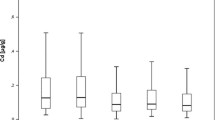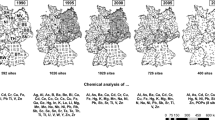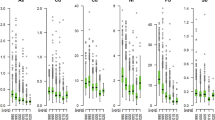Abstract
The study was conducted to test the hypothesis that the regional variability of nitrogen (N) and metal accumulations in terrestrial ecosystems are due to historical and recent ways of landuse. To this end, two regions of Central Europe were selected for investigation: the Weser-Ems Region (WER) and the Euro Region Nissa (ERN). They were assumed to have land use-specific accumulation profiles. Thus, the metal and N accumulations in both regions were examined by means of geostatistically based comparative moss analysis. The sampling and chemical analysis of mosses were conducted in accordance with the convenient guidelines and methods, respectively. The spatial representativity of the sampling sites was computed by means of a land classification which was calculated for Europe by means of classification trees and GIS-techniques. The differences of deposition loads were tested for statistical significance with regard to time and space. The measurement values corroborated the decline of metal accumulation observed since the beginning of the European Metals in Mosses Surveys in 1990. The metal loads of the mosses in the ERN exceeded those in the WER significantly. The opposite holds true for the N concentrations: those in the WER were significantly higher than those in the ERN. The reduction of emissions from power plants, factories and houses was strongly correlated with the decline of deposition and bioaccumulation of metals. As proved by the European Metals in Mosses Surveys, this tendency is due to successful environmental policies. But no such success could be verified by monitoring the accumulation of N in mosses.
Similar content being viewed by others
References
Baker, K. S., Benson, B. J., Henshaw, D. L., Blodgett, D., Porter, J. H., & Stafford, S. G. (2000). Evolution of a multisite network information system: The LTER information management paradigm. BioScience, 50(11), 963–978.
Bijok, P., & Prus, M. (Eds.) (1999). Log term ecological research. Examples, methods, perspectives for central Europe. In Proc. ILTER regional workshop, 16–18 September 1998 (pp. 143–151). Warsaw, Poland: International Centre of Ecology (Polish Academy of Science, Dziekanow Lesny).
Buse, A., Norris, D., Harmens, H., Büker, P., Ashenden, T., & Mills, G. (2003). Heavy metals in European mosses: 2000/2001 Survey, ICP Vegetation Coordination Centre, CEH. (Bangor, UK).
Bytnerowicz, A., Badea, O., Barbu, I., Fleischer, P., Fraczek, W., Gancz, V., et al. (2003). New international long-term ecological research on air pollution effects on the Carpathian Mountain forests, Central Europe. Environment International, 29(2), 367–376.
Harmens, H., Steinnes, E., Kubin, E., Rühling, A., & Schröder, W. (2005). Trends in the accumulation of N in mosses for selected European countries. (Paper presented at the 18th meeting of the Programme Task Force, Almería, Spain).
Herpin, U., Lieth, H., & Markert, B. (1995). Monitoring der Schwermetallbelastung in der Bundesrepublik Deutschland mit Hilfe von Moosanalysen. UBA-Texte 31/95, Berlin.
Hobbie, J. E., Carpenter, S. R., Grimm, N. B., Gosz, J. R., & Seastedt, T. R. (2003). The US long term ecological research program. BioScience, 53(1), 21–32.
Kratz, T. K., Deegan, L. A., Harmon, M. E., & Lauenroth, W. K. (2003). Ecological variability in space and time. Insights gained from the US LTER program. BioScience, 53(1), 57–67.
Maier, W., Grunewald, J., Habedank, B., Hartelt, K., Kampen, H., Kimmig, P., et al. (2003). Mögliche Auswirkungen von Klimaveränderungen auf die Ausbreitung von primär humanmedizinisch relevanten Krankheitserregern über tierische Vektoren sowie auf die wichtigen Humanparasiten in Deutschland. Umweltbundesamt, Forschungsbericht 200 61 218/11, Berlin.
Markert, B., Breure, A., & Zechmeister, H. G. (Eds.) (2003). Bioindicators, biomonitors. Amsterdam, The Netherlands: Elsevier.
Markert, B., Wünschmann, S., Fränzle, S., Breulmann, G., Djingova, R., Herpin U., et al. (2007). On the road from environmental biomonitoring to human health aspects of atmospheric deposition heavy metals by epiphytic plants. Present status and future needs. International Journal of Environment and Pollution, Special Edition (in press).
Mohr, K. (1999). Passives Monitoring von Stickstoffeinträgen in Kiefernforsten mit dem Rotstengelmoos (Pleurozium schreberi (Brid.) Mitt.). Umweltwissenschaften und Schadstoff-Forschung – Zeitschrift für Umweltchemie und Ökotoxikologie, 11(5), 267–274.
Pesch, R., & Schröder, W. (2006). Integrative exposure assessment through classification and regression trees on bioaccumulation of metals, related sampling site characteristics and ecoregions. Ecological Informatics, 1(1), 55–65.
Pitcairn, C. E. R., Fowler, D., & Grace, J. (1995). Deposition of fixed atmospheric N and foliar N content of bryophytes and Calluna vulgaris (L.) Hull. Environmental Pollution, 88, 193–205.
Rühling, A., & Tylor, G. (1971). Regional differences in the deposition of heavy metals over Scandinavia. Journal of Applied Ecology, 8, 497–507.
Schröder, W. (1989). Ökosystemare und statistische Untersuchungen zu Waldschäden in Nordrhein-Westfalen: Methodenkritische Ansätze zur Operationalisierung einer wissenschaftstheoretisch begründeten Konzeption. Dissertation, Christian-Albrechts-Universität zu Kiel).
Schröder, W., & Pesch, R. (2004a). The 1990, 1995 and 2000 moss monitoring data in Germany and other European countries. Trends and statistical aggregation of metal accumulation indicators. Gate to Environ. Health Sci., 1–25. doi:10.1065/ehs2004.06.011.
Schröder, W., & Pesch, R. (2004b). Spatial and temporal trends of metal accumulation in mosses. Journal of Atmospheric Chemistry, 49, 23–38.
Schröder, W., & Pesch, R. (2005). Correlation and time series of metals in mosses with selected sampling site specific and ecoregional characteristics in Germany. Environmental Science and Pollution Research, 12, 159–167.
Schröder, W., Schmidt, G., & Hasenclever, J. (2006). Bioindication of climate change by means of mapping plant phenology on a regional scale. A geostatistically based correlation analysis of data on air temperature and phenology by the example of Baden-Württemberg (Germany). Environmental Monitoring and Assessment, 130(1–3), 27–43.
Siewers, U., & Herpin, U. (1998). Schwermetalleinträge in Deutschland. Moos-Monitoring 1995. Geologisches Jahrbuch, Sonderhefte, Heft SD 2. (Stuttgart: E. Schweizerbart`sche Verlagsbuchhandlung (Nägele u. Obermiller)).
Siewers, U., Herpin, U., & Straßburger, S. (2000). Schwermetalleinträge in Deutschland. Moos-Monitoring 1995, Teil 2. Geologisches Jahrbuch, Sonderhefte, Heft SD 3. (Stuttgart: E. Schweizerbart`sche Verlagsbuchhandlung (Nägele u. Obermiller)).
Solga, A., Burkhardt, J., Zechmeister, H. G., & Frahm, J. P. (2005). N content, N-15 natural abundance and biomass of two pleurocarpous mosses Pleurozium schreberi (Brid.) Mitt. and Scleropodium purum (Hedw,) Limpr. in relation to atmospheric N deposition. Environmetal Pollution, 134, 456–473.
Steinnes, E., Rühling, Å., Lippo, H., & Makinen, A. (1997). Reference materials for large-scale metal deposition surveys. Accreditation and Quality Assurance, 2, 243–249.
UNECE (2002). ICP Vegetation Experimental Protocol for the 2001 Season, ICP Vegetation Coordination Centre, CEH. (Bangor, UK).
WGE (Working Group on Effects) (2004). Review and assessment of air pollution effects and their recorded trends. Working group on effects, convention on long-range transboundary air pollution. National Environment Council, United Kingdom.
WGE (Working Group on Effects) (2005). Air pollution and vegetation. ICP Vegetation annual report 2004/2005. Working group on effects, convention on long-range transboundary air pollution. National Environment Council, United Kingdom.
Author information
Authors and Affiliations
Corresponding author
Rights and permissions
About this article
Cite this article
Schröder, W., Hornsmann, I., Pesch, R. et al. Nitrogen and metals in two regions in Central Europe: Significant differences in accumulation in mosses due to land use?. Environ Monit Assess 133, 495–505 (2007). https://doi.org/10.1007/s10661-006-9604-z
Received:
Accepted:
Published:
Issue Date:
DOI: https://doi.org/10.1007/s10661-006-9604-z




